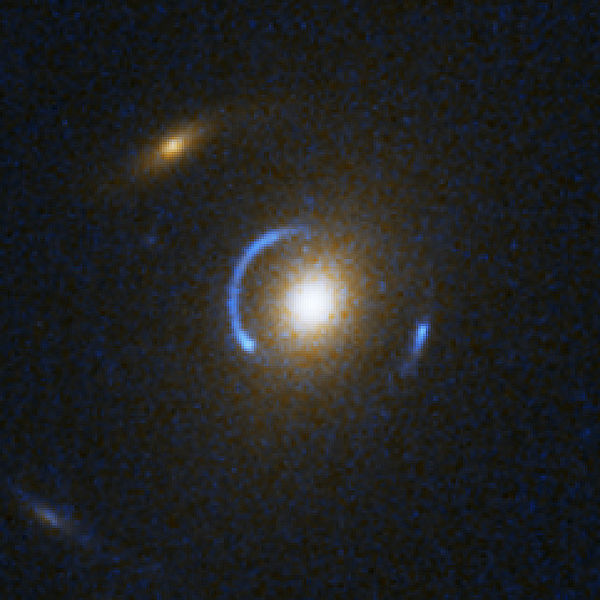A fast route to optically-faint strong gravitational lenses

An optical Einstein Ring. This Project will aim to find 100-1000s of examples that are effectively
invisible optically, but that are bright enough at long wavelengths to allow detailed study of
gas and dust at high redshift, reaching effective sensitivites matching those of
`next-generation' facilities like ALMA, JWST and SKA. In this way the project aims to answer the
question of how and when gas turned into stars in the Early Universe.
The current generation of deep multi-waveband surveys cover enough
sky area to contain perhaps 1000s of strong gravitational lenses. By magnifying
background distant galaxies in both flux and size (see Figure), these systems allow
detailed studies of distant galaxies with current telescopes without waiting
for next-generation facilities. These observations are needed to determine a key unknown in
our Universe: how gas turned into stars in the early Universe.
The problem is in identifying these lenses because most are likely to be invisibly faint at
optical wavelengths. The Herschel Satellite - to be launched in 2009 - is argued to have
unique capabilities to
pinpoint these objects because it will probe sub-millimetre wavelengths where distant star-forming
galaxies will be bright, and the flux boost due to gravitational lensing means that perhaps half of
all the objects detected will be gravitationally lensed.
The main purpose of this project is to find and characterize this population without waiting for the
full release of any Herschel data. This will be made possible by developing a new approach to
'photometric redshifts' using radio (GMRT) data as the finding survey, near-infrared surveys with
VISTA (in Chile)
to constrain redshifts,and follow-up spectroscopy and high-resolution imaging with the
world's largest telescopes.
The first year will be largely spent leading the observing and analysis of GMRT data. Most of the
Herschel lenses should be easily detectable at the low radio frequencies probed by the GMRT.
Our collaboration has been successful in obtaining a lot of time on the GMRT, and has developed
a unique data reduction pipeline; first GMRT observations for this programme will be in Jan 2009.
The other task for the first year will be to
develop a new and sophisticated `photometric
redshift' code that will start with an input catalogue from the GMRT and then use
near-infrared images, and those from complementary optical through X-ray facilities, to output
probability distributions for the redshifts of the source of the radio emission and those of any
potentially foreground lensing galaxies.
The second year will be spent applying this code to data from surveys
to be carried out on the ESO VISTA telescope
in Chile. The student will be expected to help in the collection
and processing of these data, and will lead the application of the new photometric redshift code
to these new datasets.
The third year will be spent following up the systems discovered.By default this will involve
spectroscopy with giant optical and near-infrared telescopes. It may also involve using new facilities
as they come on line like
e-MERLIN
(for high-resolution radio imaging), Herschel,and potentially
even
ALMA, ASKAP and MeerKAT.
If you are at all interested in this project
please contact any or all of the supervisors directly via email at the addresses
given below.
Steve Rawlings is Head of Astrophysics at Oxford.
Hans-Rainer Klöckner is a Postdoctoral Reseacher in Oxford,
and is the SKA Design Study (SKADS) science simulations organiser throughout
Europe.
Tom Mauch is a Postdoctoral Reseacher in observational
cosmology at Oxford, and is expert in designing and undertaking large
surveys at radio and optical wavebands.
Matt Jarvis is an RCUK Fellow and proleptic Lecturer at the University of Hertfordshire.
He is expert in observational extragalactic astronomy and PI of large surveys with the GMRT, Herschel
and VISTA.
Steve Rawlings
(s.rawlings1@physics.ox.ac.uk)
Tom Mauch
(txm@astro.ox.ac.uk)
Hans-Rainer Klöckner
(hrk@astro.ox.ac.uk)
Matt Jarvis
(M.Jarvis@herts.ac.uk)
